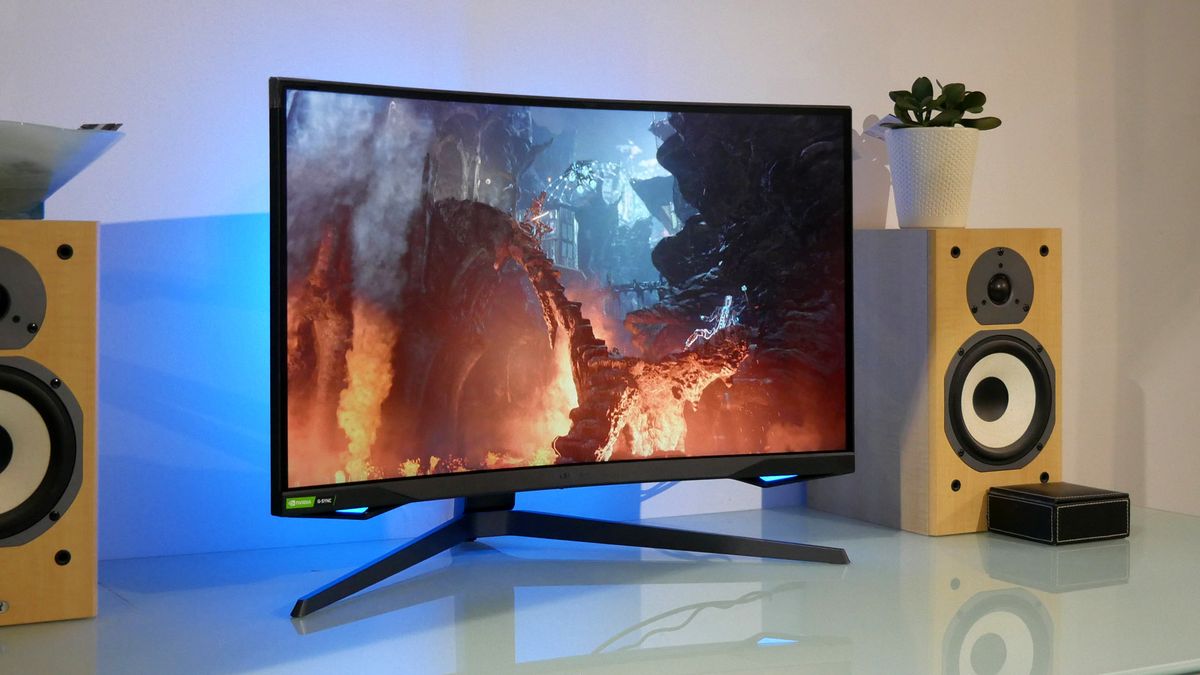Our Verdict
With the new G7, Samsung has buried the idea that VA panels can't be quick. But the extreme panel curve and mediocre HDR implementation complicate the proposition
For
- Stellar VA panel with great response
- Buttery-smooth refresh
- Great design and quality
Against
- HDR implementation is disappointing
- Curve is very extreme
- Painfully pricey for a 27-inch panel
PC Gamer's got your back
If you’re going to do something, you may as well own it. That applies to pretty much everything about the new Samsung Odyssey G7 C27G7. It’s not just a little curved. It's crazy curved. And it absolutely embraces all the latest LCD technologies intended for the best gaming monitors. Local dimming, adaptive sync, high refresh, HDR, quantum dot... it's got the works.
To put it another way, this is a monitor that doubles down on the basic concept of an LCD monitor for high performance visuals and specifically gaming. Five years ago the future looked like it was going to be OLED.
Today, this is as good as it gets.
At least, it is on paper. The G7’s core proposition involves a 27-inch 1440p VA panel with a super-tight 1000R curve. There are higher resolution panels and there are larger panels, but 27-inch and 1440p remains the sweet spot for many gamers in terms of striking the best balance between detail and frame rates. Increase the former courtesy of, say, a 4K pixel grid, and you’ll get less of the latter.
That plays neatly into the Samsung Odyssey G7’s conspicuously gamer-centric feature set.
That starts with the 240Hz refresh and claimed 1ms response. That response figure is worth noting in the context of the VA panel technology. As we were recently reminded with the AOC C27G2U, VA tech’s historical weakness has been response. Sticking with the theoreticals, the G7 supports both Nvidia G-Sync and AMD FreeSync. For the record, G-Sync support is the more limited ‘Compatible’ flavour. There are no Nvidia electronics onboard.
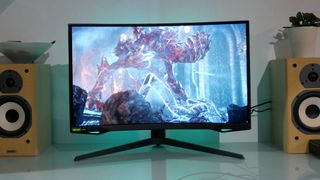
Screen size - 27-inch
Panel technology - VA
Native resolution - 2,560 x 1,440
Refresh rate - 240Hz
Response time - 1ms
Contrast - 2,500:1
Brightness - 350 nits (typical)
Inputs - HDMI 2.0, 2x DisplayPort 1.4
Other - G-Sync Compatible, FreeSync Premium, 2x USB 3.0 hub
MSRP - $600 / £629
The G7 is also VESA DisplayHDR 600 certified with local backlight dimming, more on which in a moment. The HDR capabilities include a peak brightness of 600 nits and up to 95 per cent coverage of the DCI-P3 gamut. Rounding out the main image-quality related features, the VA panel is good for a claimed 2,500-to-one contrast and Samsung has integrated both a low input lag mode and user-configurable overdrive including a motion-blur reduction mode.
Inputs-wise, you’re looking at HDMI and DisplayPort but not USB-C. The latter is arguably a conspicuous omission, especially given the lofty price point. But with the gaming remit, it probably makes sense. Although USB-C power delivery maxes out at a theoretical 100W, the most we’ve seen a monitor supply is 65W. Anyway, even 100W isn’t nearly enough for a high performance gaming laptop.
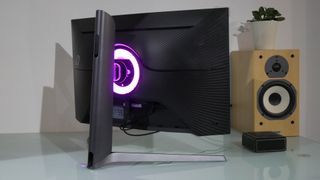
To all that you can add a two-port USB-A hub, Samsung’s rear-mounted Core LED mood lighting and a height and tilt adjustable stand and chassis with styling and build quality that blows most PC monitors out of the water. Like we said, on paper this thing rocks.
It does in practice, too, for the most part. To punt our greatest worry immediately into the stands and consign it to history, the G7 has absolutely stellar pixel response. It’s quick even in the least aggressive of its overdrive modes. With overdrive maxed out, the G7 is even better and suffers from little or no overshoot or inverse ghosting.
That’s seriously impressive and reflects the fact that Samsung itself is heavily invested in producing VA technology and arguably makes the finest such panels in the world.
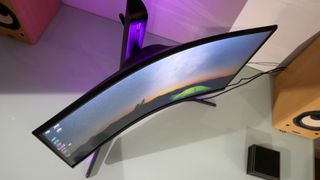
For general feel and accuracy, the G7 is fantastic, too. At a glance, you’d be hard pressed to distinguish it from a very good IPS panel when it comes to colour balance. But with that you also get the much better contrast and black levels of VA. That’s a fabulous combo. Factor in buttery smooth 240Hz refresh and adaptive sync and, well, this is one heck of a gaming panel.
But it’s also slightly flawed.
Technically, the main shortcoming involves HDR support. As implied by the DisplayHDR 600 certification, the backlight supports local dimming. But there are just eight edge-lit vertical zones. It’s such a kludgy, half-arsed solution, the G7 would arguably be better off with a single fixed backlight.
Whatever, this is not a true HDR display. It’s better thought of as a really punchy SDR panel and, indeed, in our testing that’s how it performs best, including comparing games with lots of darker scenes that support HDR, like Metro Exodus, in both SDR and HDR modes.
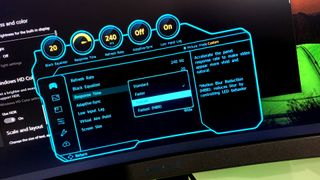
The other major question mark involves the extreme 1000R panel curvature. It certainly gives the G7 a dramatic wrap-around feel. It works pretty well in-game, which is, after all, the main remit. But it’s rather distracting and distorted on the Windows desktop, limiting this monitor’s appeal as an all rounder.
Those caveats aside, this remains a pretty fabulous gaming panel. If you’re looking for a 1440p monitor, and price isn’t really an issue, the G7 should almost certainly be on your shortlist. But it is all a reminder, not only of the ultimate limitations of LCD technology, but also the care needed when making assumptions, both for better and worse.
On the one hand, the G7 proves that VA technology can rival TN for pixel response. On the other, it confirms HDR with local dimming guarantees little in the real world.
With the new G7, Samsung has buried the idea that VA panels can't be quick. But the extreme panel curve and mediocre HDR implementation complicate the proposition

Jeremy has been writing about technology and PCs since the 90nm Netburst era (Google it!) and enjoys nothing more than a serious dissertation on the finer points of monitor input lag and overshoot followed by a forensic examination of advanced lithography. Or maybe he just likes machines that go “ping!” He also has a thing for tennis and cars.

A 2023 study concluded CAPTCHAs are 'a tracking cookie farm for profit masquerading as a security service' that made us spend 819 billion hours clicking on traffic lights to generate nearly $1 trillion for Google

Helldivers 2 game master Joel offers a look back on the first anniversary of the galactic war

The Roottrees are Dead review
